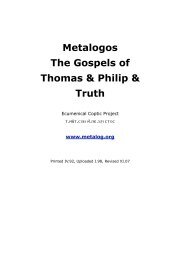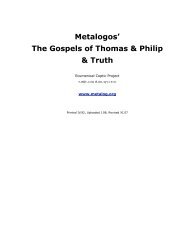Andrew Louth - Syriac Christian Church
Andrew Louth - Syriac Christian Church
Andrew Louth - Syriac Christian Church
Create successful ePaper yourself
Turn your PDF publications into a flip-book with our unique Google optimized e-Paper software.
COSMIC THEOLOGY 67<br />
emptying love in the Incarnation: apart from that it is nothing, ascetic<br />
struggle can achieve nothing on its own. Maximus brings out these<br />
points in Amb. 10 by the structural significance that the metaphor of<br />
the ‘cloud’ plays in it. In the passage from Gregory’s sermon with<br />
which this Difficulty engages there is mention of the ‘fleshly’ being<br />
called ‘cloud or veil’. It is by overlooking this that the Origenists find<br />
support from Gregory for their ignoring (or rapidly passing over) ascetic<br />
struggle. For Maximus, on the contrary, it is the imagery of the cloud<br />
that makes clear the crucial significance of ascetic struggle, for both<br />
the reasons outlined above. The first three sections of this Difficulty<br />
discuss how the soul operates in conjunction with the body. The<br />
fleshly, that is the disordered lower part of the soul, obscures and<br />
obstructs the soul’s natural movement towards God (which is fulfilled<br />
in contemplation): it is fittingly called the cloud, therefore, and<br />
engagement with the cloud is precisely ascetic struggle, and is seen to<br />
be not so much preliminary as fundamental.<br />
But as Maximus discusses the significance of the cloud, his mind<br />
moves laterally—to the biblical imagery of the cloud. (It is important<br />
to be open to the lateral movement of Maximus’ reflections: otherwise<br />
it is difficult to discern any train of thought at all.) Section 4 begins a<br />
series of meditations (or contemplations: theôriai) ofpassagesfrom<br />
the Old Testament. It is the cloud, that led the people of Israel in the<br />
desert, that introduces these considerations, but because this cloud is<br />
first mentioned at the crossing of the Red Sea (Exod. 14. 15–29; cloud<br />
mentioned at verse 19), Maximus’ mind moves—again laterally—to the<br />
notion of crossing (diabasis) that is the general subject of the passage<br />
from Gregory that he is expounding.<br />
THE TRANSFIGURATION<br />
These examples from the Old Testament culminate in the meditation<br />
on the Transfiguration that they all prefigure. In the Transfiguration,<br />
the themes of crossing over and the cloud are once again brought<br />
together, but this time in conjunction with the Incarnation. The<br />
Incarnation reveals the mutually-encountering crossings-over—of God<br />
to humankind and of humankind to God. In the Transfiguration the<br />
glory of God Incarnate is revealed; in the Transfiguration the disciples<br />
pass over ‘from flesh to spirit’ and behold ‘the glory as of the Onlybegotten<br />
of the Father, full of grace and truth’. But Maximus draws<br />
our attention to the fact that in the Transfiguration it is not only the<br />
face of the Incarnate One that is transfigured with light, but also his<br />
clothes, and he suggests that the radiant garments have a double<br />
significance. The radiant garments can be understood as a ‘symbol of<br />
the words of Holy Scripture, which in this case became shining and




